Everyone’s talking about the Michelin Key but few know the full story behind the world’s most famous rating system.
7 things you (probably) didn’t know about Michelin
Here are 7 facts that might surprise you:
1️⃣ It started as a marketing tool.
Back in 1900, Michelin created the Michelin Guide not for foodies but to sell more tyres. The idea: get drivers to travel more, wear down tyres and need replacements.
2️⃣ The star system came later.
Stars weren’t introduced until 1926 and originally, there was only one. The 3-star hierarchy (“worth a detour”, “worth a journey”) arrived in 1931.
3️⃣ Inspectors are anonymous even to each other.
They don’t reveal their identities, avoid media, and sometimes don’t even meet other inspectors to maintain objectivity.
4️⃣ Michelin doesn’t just rate restaurants.
It’s now rating hotels too the new Michelin Key celebrates exceptional stays that combine character, service, and design (think: soul meets sophistication).
5️⃣ A star can be taken away.
Restaurants have lost stars for inconsistency, menu shifts, or even because a chef didn’t want the pressure.
6️⃣ You can’t apply.
You can’t nominate yourself or your property Michelin chooses who to inspect based on research, buzz, and guest feedback.
7️⃣ It’s global but still selective.
The guide covers 45+ countries, yet many world-class destinations still aren’t rated. That scarcity is part of its power.
Whether it’s a ⭐ or a 🗝️ Michelin’s magic lies in its credibility, consistency and storytelling.
It’s proof that a 120-year-old brand can keep reinventing itself and still set the global benchmark for excellence.
What other legacy brands do you think could pull off a reinvention like this?
And did you know this about Michelin already?







